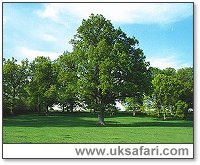
|

|
|
 Sent
to you Sent
to you
by e-mail
|
|
Simply
enter your details and hit the send button
more
info |
|


Click Here

Links
Advertise
Terms of Use
Contributors
About Us
Contact Us
|
 |
Go back
 | Bookmark
| Bookmark
 | Print Page
| Print Page  | E-Mail Us
| E-Mail Us 
 

Photo: G. Bradley |
|
UK
Safari Tip:
To help you identify different trees get the colourful fold out chart
called "Tree Name Trail" from the Nature Shop - click
here
|
|
Latin name: Quercus robur
Size: Up to 35 metres
Distribution: Found throughout the UK
Flowering months: May. The male flowers hang down on bright green catkins. Near the tip of each twig, on the end of long stalks, are the reddish-brown coloured female flowers.
Special features: Sometimes called the 'English' oak. When growing in open areas it has a wide, rounded crown, but woodland specimens are usually tall and slender. The timber of the oak has been used in the building of ships, houses, furniture and gates. The bark is used in the tanning of leather.
The leaves (see picture) appear just before the flowers in April. They have four or five lobes on each side, and no stalks where they join to the branches of the tree. At the base of the leaf there are rounded flaps on each side.
Every year, around September, the tree develops its fruits called 'acorns'. The acorns develop at the ends of long stalks called 'peduncles'. It is these stalks which give the tree its alternative name the
'pedunculate oak'. The acorns contain the seeds of the tree. They are also a useful source of food for squirrels and jays.
The English oak is a deciduous tree, and in the autumn, usually around November, it sheds its leaves.
Did You Know?
The oak tree can be home to more than 300 species of invertebrates.

Photo of an
Oak Tree Leaf
UK Safari Tree Section
|
 |

|